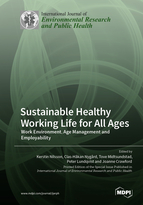Sustainable Healthy Working Life for All Ages—Work Environment, Age Management and Employability
A special issue of International Journal of Environmental Research and Public Health (ISSN 1660-4601).
Deadline for manuscript submissions: closed (15 June 2022) | Viewed by 38234
Special Issue Editors
Interests: sustainable working life for all ages, public health, health promotion and prevention, work environment, work organisations, age management, age discrimination, employability
Special Issues, Collections and Topics in MDPI journals
Interests: occupational health; aging and work; occupational gerontology; strain at work; work ability and promotion of health and work ability; ergonomics
Special Issues, Collections and Topics in MDPI journals
Interests: pension systems and pension policy; retirement behaviour; age and work; age management; health promotion and prevention; lifelong learning
Special Issues, Collections and Topics in MDPI journals
Interests: health and safety; social sustainability in agriculture
Special Issues, Collections and Topics in MDPI journals
Interests: occupational health and safety; age and work; ergonomics and work design
Special Issues, Collections and Topics in MDPI journals
Special Issue Information
Dear Colleagues,
The proportion of elderly citizens is continuously increasing in most of the industrial world [1–3]. The current demographic trend is characterised by increased longevity and lower fertility rates and is leading to an increasingly ageing population. The retirement age in many countries is being postponed in order to adapt the economic and budgetary implications of increased longevity to the new demographic distribution. Older people are encouraged to keep working and to participate in the labour force for as long as possible [1–3]. The demographic situation stresses the importance of factors that motivate older employees and self-employed individuals to keep working and to maintain their employability until an older age, as well as the organisations and enterprises to care for their employees’ employability until an age older than the one considered, so far, the retirement age [4–7].
Against this backdrop, the International Journal of Environmental Research and Public Health is announcing a Special Issue titled “Sustainable Healthy Working Life for All Ages—Work Environment, Age Management and Employability”. This Special Issue will provide an outlet for research contributing to the development of our theoretical and practical knowledge in these domains influencing people’s working life.
We are interested in scientific analyses, case studies, or interventions that generate original and innovative insights into the proposed topic and focus on the nine determinants of a healthy and sustainable working life for all ages, identified in the swAge-model [4,5], which are:
1) self-rated health, diagnoses, functional diversity
2) physical work environment
3) mental work environment
4) work schedule, work pace, time for recuperation
5) personal finances, work ability, employability
6) personal social environment and work–life balance
7) work social environment, discrimination, leadership and age management
8) motivation, stimulation and satisfaction with work tasks
9) knowledge, skills, competence
The “Sustainable Healthy Working Life for All Ages—Work Environment, Age Management and Employability ” Special Issue is jointly organized between “Sustainability” and “International Journal of Environmental Research and Public Health” journals. Authors in the Special Issue can submit their papers to “Sustainability” or “International Journal of Environmental Research and Public Health”.
We look forward to receiving your contributions.
References
- OECD. Pensions at a glance 2019. OECD and G20 indicators. Paris: OECD Publishing; 2019. doi:10.1787/b6d3dcfc-en.
- WHO. World report on ageing and health. Geneva: World health organization; 2017. http://www.who.int/ageing/publications/world-report-2015/en/
- OECD. Health at a glance 2019: OECD indicators. Paris: OECD Publishing; 2019. doi:10.1787/4dd50c09-en.
- Nilsson K. Conceptualization of ageing in relation to factors of importance for extending working life – a review. Scandinavian Journal of Public Health. 2016; 44: 490–505.
- Nilsson K. A sustainable working life for all ages – The swAge-model. Applied Ergonomics 2020; 103082: 1-27. https://0-www-sciencedirect-com.brum.beds.ac.uk/science/article/pii/S0003687018305313?dgcid=author
- Fleuren BP. de Grip A. Jansen NWH. Kant I. Zijlstra FRH. Unshrounding the Sphere from Clouds: Towards a Comprehensive Conceptual Framework for Sustainable Employability. Sustainability. 2020;12:6366. doi:10.33909/su12166366.
- Van der Klink JJL. Bültmann U. Burdorf A. Schaufeli WB. Zijlstra FRH. Abma FI. BRouwer S. van der Wilt GJ. Sustainable employability – definition, conceptualization, and implications: A perspective based on the capability approach. Scand J Work Environment Health. 2016;42(1):71-79.
Kind regards,
Prof. Dr. Kerstin Nilsson
Prof. Dr. Clas-Håkan Nygård
Dr. Tove Midtsundstad
Prof. Dr. Peter Lundqvist
Prof. Dr. Joanne Crawford
Guest Editor
Manuscript Submission Information
Manuscripts should be submitted online at www.mdpi.com by registering and logging in to this website. Once you are registered, click here to go to the submission form. Manuscripts can be submitted until the deadline. All submissions that pass pre-check are peer-reviewed. Accepted papers will be published continuously in the journal (as soon as accepted) and will be listed together on the special issue website. Research articles, review articles as well as short communications are invited. For planned papers, a title and short abstract (about 100 words) can be sent to the Editorial Office for announcement on this website.
Submitted manuscripts should not have been published previously, nor be under consideration for publication elsewhere (except conference proceedings papers). All manuscripts are thoroughly refereed through a single-blind peer-review process. A guide for authors and other relevant information for submission of manuscripts is available on the Instructions for Authors page. International Journal of Environmental Research and Public Health is an international peer-reviewed open access monthly journal published by MDPI.
Please visit the Instructions for Authors page before submitting a manuscript. The Article Processing Charge (APC) for publication in this open access journal is 2500 CHF (Swiss Francs). Submitted papers should be well formatted and use good English. Authors may use MDPI's English editing service prior to publication or during author revisions.










